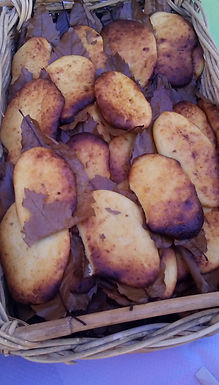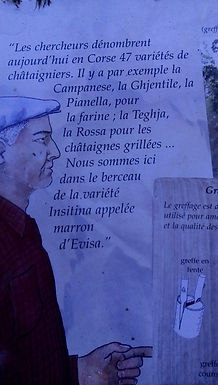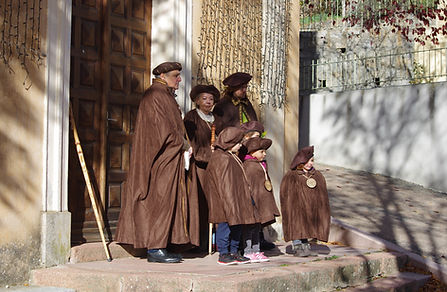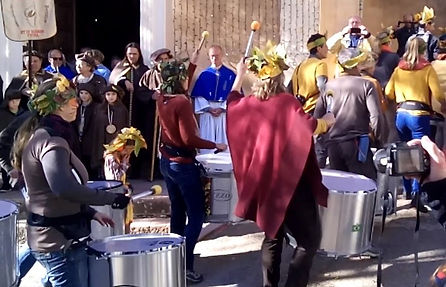chestnut
Castanea sativa
November
Many events have traditionally been held across Europe each Autumn to celebrate the harvesting of chestnuts.
Here are a few that have generally taken place in November, though they can also be held in December
For more information about chestnuts and other chestnut festivals also see 'October'
FRANCE
Corsica
Renowned for its chestnut woods which for centuries, shaped the way of life of those who lived among or near them, providing food for both people and animals as well as the timber for everything from house construction and furnishings to coffins, Corsica celebrates its long dependence upon sweet chestnuts with festivals held in late Autumn. The chestnut tree - many in the region are several hundred years old - is a symbol of local identity.
Evisa
In the medieval village of Evisa, in western Corsica, perched in the hills at 850 m, surrounded by some 250 has of chestnut groves, on the edge of the Foret D'Aitone, a Fete du Marron (and for the last few years du Champignon also) has been held since 1991 at the end of November. While the 28th Chestnut & Mushroom Festival was held on 24th November 2021, and the 2023 celebration was held on the 2nd & 3rd December, the 2024 celebration is scheduled for the last week of November.
Preceded by Mass in the village church and procession of the 'Confrerie du Marron d'Evisa', (the Brotherhood of the Evisa Chestnut), the festival offers various attractions, local produce being the central focus, but also exhibitions, music, culinary demonstrations and events including the induction of new members to the Brotherhood.
Stands filling the central part of the main road that winds its way down from the mountains to the sea at Porto, some 10 kms away, offer chestnut flour - given AOP (Appellation d'Origine Protegee status since 2010 for its quality and flavour) - and other chestnut-related foods, including honey produced by bees that have foraged on the trees' flowers as well as those of the island's maquis vegetation, falculelle - flat, fritter-like cakes, and an array of sausages made from the meat of the pigs that wander at liberty through the chestnut woodland - these are local breeds that enjoy a diet that also includes acorns.
Visitors are encouraged to walk along the 'Sentier du chataigner' - a pathway that winds for 3.5 km through the chestnut woods above the village, an ancient route of 'transhumance' followed by generations of shepherds, which now has information boards along its length explaining the historic importance of the chestnut in local culture, its cultivation and many uses.
See: https://www.visit-corsica.com/eng/Mon-sejour/Manifestations/Toutes-les-manifestations/CHESTNUT-AND-MUSHROOM-FESTIVAL
For an excellent summary of the significance of chestnut cultivation in Corsica, see 'Revisiting the Resilience of Chestnut Forests in Corsica: From Social-Ecological Systems Theory to Political Ecology' , Genevieve Michon, Ecology and Society Vol. 16, No. 2 (Jun 2011)]
in mainland FRANCE
Fête des Châtaignes beginning in October and running into November, have become a feature of many villages of the Alpes-Maritimes area and other chestnut-growing regions of France.
The Ardeche for example, which produces half of the country's chestnuts, typically hosts 11 celebrations at different locations, Les Castagnades, throughout October and into November.
Two taking place in November 2024 were at:
Vesseaux - 2nd & 3rd November &
Joannas - 9th & 10th November
[https://www.castagnades.fr/castagnades/programme-des-fetes/]
[https://www.castagnades.fr/evenements/castagnade-20/?occurrence=2023-11-11%22]
https://www.castagnades.fr/wpcontent/uploads/sites/3/Castagnades_Programme_2024_OK_web.pdf
ITALY
Tuscany
Piancastagnaio, Siena province
October - November
One of the the oldest and largest of Tuscan chestnut festivals is the Crastatone, (from the verb 'crastare', meaning to cut the top of the chestnut before roasting it) which takes place at the foot of Mount Amiata, in the ancient village of Piancastagnaio. Until World War II chestnuts were the main source of food available to people of the Mount Amiata region.
'Between October and November ... the medieval village celebrates the end of the chestnut harvest season and the arrival of Winter with a festival full of events. Visitors can enjoy art exhibitions, buy presents in the art & craft fairs or taste local delicacies in the restaurants of Piancastagnaio'.
Specialities include:
'crastate (roasted chestnuts), brodolose (boiled chestnuts with fennel), vecchierelle (dried chestnuts), suggioli (boiled chestnuts with peel), castagnaccio (chestnut flour cake), & pulenna doicce (sweet polenta)
[https://www.italybyevents.com/en/events/tuscany/crastatone-piancastagnaio-chestnut/]
[https://www.valdorciamiata.it/en/piancastagnaio-chestnut-festival/]
For more about Tuscan chestnut festivals in October & November see:
[https://lovefromtuscany.com/chestnut-festivals-in-tuscany/]
It explains that:
'An important word to learn for anyone who loves chestnuts is “marroni“. This is the word for the most prized Tuscan chestnut variety, with its crunchy and irresistible sweet pulp. (The more general word for chestnut is ‘castagna‘).
'The “Marroni del Mugello” IGP and “Marroni di Caprese Michelangelo” DOP are the VIP’s of Tuscan chestnuts. Delicious when eaten roasted or boiled, and are also used to make marron glacé, cakes and desserts (like the typical castagnaccio) and ravioli'
GREECE
Cyprus
Elos Chestnut Festival, near Kissamos, western Crete
Each year at the end of October/early November
See: 'October'
_JPG.jpg)

Of some 47 varieties of chestnut that are said [see photo below right] to be found in Corsica, three are dominant in this area: the insidina, the tricciuda and the nocella. The insidina is considered to have exceptional qualities with regard to taste and texture and, designated the 'Marron d'Evisa', is particularly recognized for the production of marron glaces. Over 20 different procedures are involved in producing these distinctive delicacies
The 'Marron d'Evisa' refers to chestnuts gathered in the region of the villages of Cristinacce and Marignana as well as Evisa.
Today most chestnuts, however, are eaten by the pigs - local breeds that enjoy a diet that also includes acorns - that have free range in the woods, and which are the source of a varied traditional charcuterie.
Sausage production is based on know-how, passed down many generations, producing a range of distinctive products including: figatellu (based on pigs' liver), lonzu (including dried and salted pork), coppa (made with pork shoulder), salsiciu (a sausage dried by natural fermentation) and prisuttu (raw ham dried for up to 18 months).
Following the harvest in October and November, to produce flour, chestnuts are still dried in traditional driers for between 20 and 30 days, then mechanically shelled and sorted, before baking to remove their inner skin. They are then milled with a granite grindstone in a traditional mill, now powered electrically or hydraulically.
Drought and infestation by the Oriental chestnut gall wasp, Dryocosmus kuriphilus, (locally referred to as cynips) an insect of Asian origin whose larvae cause abnormal growths, galls, to form on the buds, leaves and leaf stalks, have in recent years, been responsible for weakening or killing many trees. This worrying trend has seriously affected chestnut production. Between 2010 and 2017, chestnut production fell by 60%.
[www.evisa.fr]
[https://www.corse.fr/agenda/Fete-du-Marron_ae79131.html]
[https://www.corsematin.com/articles/a-evisa-la-fete-du-marron-resiste-malgre-labsence-de-chataignes-78322]



.jpg)